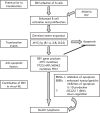Epstein- Barr Virus: Clinical and Epidemiological Revisits and Genetic Basis of Oncogenesis
- PMID: 26862355
- PMCID: PMC4740969
- DOI: 10.2174/1874357901509010007
Epstein- Barr Virus: Clinical and Epidemiological Revisits and Genetic Basis of Oncogenesis
Abstract
Epstein-Barr virus (EBV) is classified as a member in the order herpesvirales, family herpesviridae, subfamily gammaherpesvirinae and the genus lymphocytovirus. The virus is an exclusively human pathogen and thus also termed as human herpesvirus 4 (HHV4). It was the first oncogenic virus recognized and has been incriminated in the causation of tumors of both lymphatic and epithelial nature. It was reported in some previous studies that 95% of the population worldwide are serologically positive to the virus. Clinically, EBV primary infection is almost silent, persisting as a life-long asymptomatic latent infection in B cells although it may be responsible for a transient clinical syndrome called infectious mononucleosis. Following reactivation of the virus from latency due to immunocompromised status, EBV was found to be associated with several tumors. EBV linked to oncogenesis as detected in lymphoid tumors such as Burkitt's lymphoma (BL), Hodgkin's disease (HD), post-transplant lymphoproliferative disorders (PTLD) and T-cell lymphomas (e.g. Peripheral T-cell lymphomas; PTCL and Anaplastic large cell lymphomas; ALCL). It is also linked to epithelial tumors such as nasopharyngeal carcinoma (NPC), gastric carcinomas and oral hairy leukoplakia (OHL). In vitro, EBV many studies have demonstrated its ability to transform B cells into lymphoblastoid cell lines (LCLs). Despite these malignancies showing different clinical and epidemiological patterns when studied, genetic studies have suggested that these EBV- associated transformations were characterized generally by low level of virus gene expression with only the latent virus proteins (LVPs) upregulated in both tumors and LCLs. In this review, we summarize some clinical and epidemiological features of EBV- associated tumors. We also discuss how EBV latent genes may lead to oncogenesis in the different clinical malignancies.
Keywords: EBV; Epithelial tumors; Latency; Lymphoid tumors; Oncogenes; Oncogenesis.
Figures
References
-
- Payne D.A., Mehta S.K., Tyring S.K., Stowe R.P., Pierson D.L. Incidence of Epstein-Barr virus in astronaut saliva during spaceflight. Aviat. Space Environ. Med. 1999;70(12):1211–1213. - PubMed
Grants and funding
LinkOut - more resources
Full Text Sources
Other Literature Sources

